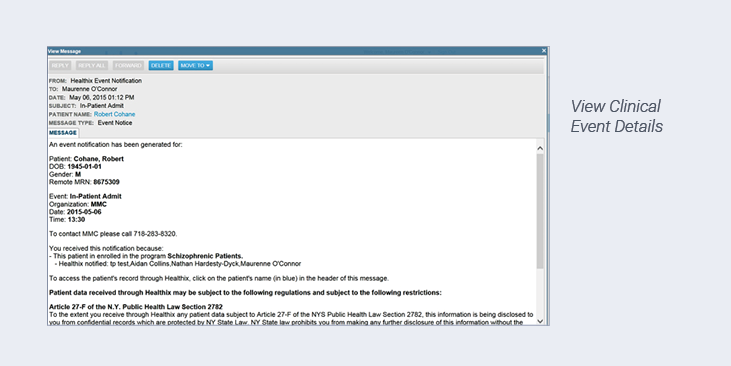
Providers and care teams can benefit from receiving Healthix Alerts. Alerts enable intervention at the point-of-care, facilitate care coordination and provide key information about your patient’s or client’s encounters across New York State regardless of provider.
What Triggers Patient Alerts
Healthix Alerts fall into two broad categories. Standard alerts are triggered by an event, such as an admission/discharge from an emergency department, or inpatient hospital stay or from a rehab/long-term care facility. Advanced alerts require analysis to determine the status of the patient. Thresholds and criteria are established and if a patient meets the criteria outlined (e.g., lab detection for HepC) an alert will be triggered. Specific Healthix Alerts currently live are listed in the right sidebar.

How to Select Patients for Alerts
Providers may choose to pre-select a group of patients for whom the wish to receive alerts (i.e., chronically ill high risk patients such as diabetics or those with CHF). Pre-selecting a group of patients is called a subscriber list. Providers may also choose to follow all of their patients. (Note: this will likely result in a significant number of alerts, and a workflow to triage these should be considered in advance to optimize the alerts impact).
How Patient Consent Impacts Alerts
- Alerts can be triggered if the patient has not made a consent decision or remains “undecided.” These alerts include basic health information (encounter information – name, location, date, diagnoses, chief complaint).
- Consent is required to access the patient’s full medical history (procedures, medications, lab values, imaging results and more).
- If a patient elects to deny consent, alerts will not be sent to providers or care managers.

Benefits
- Provides information 24/7 in real-time, so provider can intervene at point-of-care.
- Keeps provider informed of care occurring outside their network and across provider types.
- Allows for follow-up care from post hospital or ED discharge.
- Helps with planning resource allocation and interventions.
- Improves patient satisfaction.
Healthix Alerts


